
AKATSUKI was successfully inserted into orbit around Venus in December 2015. A previous attempt, five years ago, failed due to a damaged engine, and since then the probe has been orbiting the Sun, waiting for the next opportunity to approach Venus. Now, tests of observation equipment have been completed, and full-scale observation is due to begin around April. We asked AKATSUKI Project Scientist Takeshi Imamura what kind of results we can expect.
Focus on the climate
— First of all, tell us what is interesting about Venus.
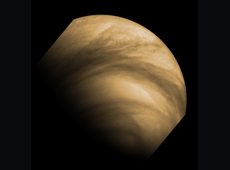 Venus covered with acid clouds (courtesy of ESA/MPS/DLR/IDA)
Venus covered with acid clouds (courtesy of ESA/MPS/DLR/IDA)
The most appealing thing about Venus is the question, “Why is Venus so different from Earth?” Venus is the same kind of solid-rock planet as Earth, and does not differ much from it in size or mass. Therefore, we think that the composition of its atmosphere at birth may have closely resembled that of Earth. But Venus’s current environment is completely different. Earth’s atmosphere is composed mainly of nitrogen and oxygen, whereas Venus’s is almost completely carbon dioxide, and its skies are covered with thick sulfuric acid clouds.
Venus looks bright from Earth because these sulfuric acid clouds reflect the light of the Sun – this is why it’s always captured people’s interest. But Venus is a very difficult planet to explore. Until fairly recently, only American and Soviet probes had studied Venus, but because of these clouds, they had trouble seeing the planet underneath. Also, because the surface temperature is more than 400℃ and the atmospheric pressure is over 90 Earth atmospheres, the probes were not able to move around freely and study the planet. As a result, many puzzles remain, which AKATSUKI is going to try to solve. For example, we’re going to do a thorough study of the climate. Venus’s atmosphere is in a state of super-rotation – it circles the planet at speeds of up to 400 km/h, at an altitude of 60 km – a kind of ultra-high-speed wind. Venus rotates slowly, with one rotation taking 243 Earth days, but in the skies above it there is a ferocious wind. Where does this wind come from? How are the sulfuric acid clouds formed? AKATSUKI will attempt to answer these questions.
— The current environments on Venus and Earth are totally different, but when the planets were formed they were similar. Is that correct?
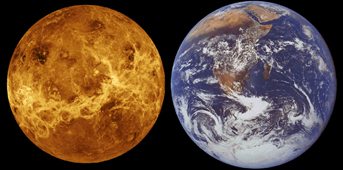 Venus and Earth (courtesy of NASA, JPL)
Venus and Earth (courtesy of NASA, JPL)
Yes. The surface temperature on Venus today is very high, and there are no oceans. But some scientists think there may have once been oceans on Venus. Its atmosphere is made up mainly of carbon dioxide, but Earth also has a lot of carbon dioxide. The difference is that on Earth it’s hidden underground, and absorbed into oceans and rivers. Carbon dioxide that is dissolved in water combines with minerals such as calcium to form carbonate minerals, which are hidden at the bottom of the oceans. But if Earth were to move closer to the Sun, like Venus, it is possible that its temperature would rise with the heat of the Sun, all the water would evaporate, the carbon dioxide in the ground would be released, and it would become like Venus – a planet covered in a thick layer of carbon dioxide.
If we can find out how Venus became the scorching-hot world that it is now, we should be able to understand how special Earth’s environment really is. We need to know more about Venus in order to know more about Earth. Environmental problems on Earth are becoming more serious, and Venus may be an example of the ultimate result of global warming. Studying Venus may allow us to see how Earth’s climate will change if greenhouse gas emissions continue to increase. That’s another reason that exploring Venus is really significant.
New aspects of Venus unveiled
— Tell us about the current status of the probe.
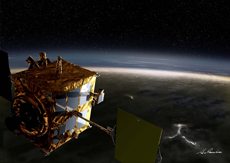 AKATSUKI (courtesy of Akihiro Ikeshita)
AKATSUKI (courtesy of Akihiro Ikeshita)
Since our probe started its orbit of Venus last December, we have been testing its six observation instruments and performing initial observations. When we start using a camera, for example, we can make adjustments such as changing the exposure. We will be able to start full-scale observation – around April of this year.
— Will all the equipment be used simultaneously?
AKATSUKI is equipped with five cameras, which observe Venus at different light wavelengths, and one instrument for measurement using electromagnetic waves. The cameras observe the atmosphere at different heights: the visible-ray camera looks for lightning; mid- infrared looks at cloud temperature distribution; ultraviolet looks at the chemical substances at the top of the clouds; near-infrared (1μm) looks at the planet surface, and another near-infrared (2μm) observes the lower atmosphere. Electromagnetic waves sent from the probe and received on Earth tell us about the vertical structures of the temperature and other features of the Venusian atmosphere. Looking from Earth, there are times when the probe is hidden behind Venus. When the probe is just coming back into view, its electromagnetic waves glance off the edge of the Venusian atmosphere. By studying the fluctuations of the electromagnetic waves at such times, we can get information on the atmosphere.
All this observation equipment will be working simultaneously, although not necessarily in unison. Cameras that only observe Venus on the dayside will be resting while the probe is on the nightside. The most important thing about AKATSUKI is the simultaneous and continuous study of the Venusian atmosphere with multiple wavelengths of light, and the three-dimensional capture of these movements. We can’t achieve our goals using just one camera taking one type of image. Venus looks completely different depending on the wavelength, so by combining multiple data, we can get a more complete picture of the movement of the atmosphere and the origin of the clouds.
— Some early images from AKATSUKI have now been released. How did that feel?
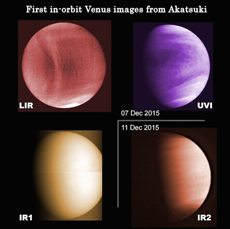 Venus photographed with different wavelengths. Cloud temperature distribution (top left, mid-infrared), distribution of sulfur dioxide, which becomes a component of the sulfuric acid clouds (top right, ultraviolet), sunlight scattering caused by clouds (bottom left, near-infrared), difference in the elevation of clouds (bottom right, near-infrared). (There is no significance in the coloring.)
Venus photographed with different wavelengths. Cloud temperature distribution (top left, mid-infrared), distribution of sulfur dioxide, which becomes a component of the sulfuric acid clouds (top right, ultraviolet), sunlight scattering caused by clouds (bottom left, near-infrared), difference in the elevation of clouds (bottom right, near-infrared). (There is no significance in the coloring.)
I had a pretty strong reaction to seeing the images that were taken right after AKATSUKI was inserted into orbit. Even with just these images, we have made a number of discoveries, and our science team is extremely excited. When we saw full images of Venus taken by the observation cameras that we had personally developed, we were beside ourselves with joy! That’s when we really felt that we had finally arrived at Venus.
— What kinds of discoveries have been made from these images?
The thing that we scientists are most excited about are the images taken by the mid-infrared camera. Looking at these images, which capture the temperature distribution of Venusian clouds, we can see a bow-like white pattern from the northern hemisphere to the southern hemisphere, straddling the equatorial area. The white coloring shows areas where temperatures are high. High-speed winds of 400 km/h blow from east to west on Venus, so we can see the streaks from east to west, but how a band structure can run from north to south is a puzzle. We never imagined that we would see this kind of thing.
Images that are taken with the ultraviolet imager have also shown us aspects of Venus that we had never seen before. This is the first time we have imaged Venus with the ultraviolet wavelength that allows us to see sulfur dioxide. Ultraviolet rays from the Sun cause a chemical reaction, and the sulfur dioxide in the atmosphere changes into sulfuric acid. This is the origin of the sulfuric acid clouds that cover the planet, but we don’t know where and how this sulfur dioxide is carried to the top of the clouds. As we continue our analysis of these images, we hope to understand how the sulfuric acid clouds are created, and why the planet is covered with them. Personally, I am very interested in this.
In addition, the images captured by the near-infrared camera are very interesting. From these images, we can see that the clouds are low at the north and south poles, but high near the equator. This large-scale difference of elevation is overlain with striped pattern from east to west. This striped pattern may be caused by the super-rotation, which blows from east to west, but it is a mystery why clouds should be higher or lower depending on location. So even these initial observation images are giving us one piece of new information after another. So we are delighted! At the moment, we are taking only still images, but starting April we will be recording the first ever video of the movements of the atmosphere and clouds of Venus. I think after that our understanding will progress in leaps and bounds.
Changing the Last Five Years to a Positive
— AKATSUKI waited five years for an orbit insertion opportunity. How did you feel when insertion was successful?
When I saw that our second attempt to insert AKATSUKI into orbit had worked, I got so emotional I could hardly speak. This happened on December 7, 2015, five years to the day after our first attempt had failed. That failure happened because a fuel-supply valve had closed and an abnormal combustion occurred in the main engine leading to its destruction. This time we maneuvered the probe by firing its four attitude-control thrusters instead of the damaged main engine. These thrusters are quite small – the four of them together have just one-fifth the power of the main engine. We fired them for about 20 minutes in the opposite direction to the probe’s flight path – in other words, applying the brakes. And then AKATSUKI was pulled into orbit by Venus’s gravity. This was the first time in history that a probe had been inserted into planetary orbit using just the attitude control engines. The day of the operation we were watching with bated breath, trusting the skill of the orbit control team. When we saw that the engine thrust had gone exactly according to plan, we knew that we had been successful.
— How did you maintain your motivation over the five years it took until the second attempt?

When the initial orbit insertion failed, our goal seemed very far away, but we always had a strong will to succeed with AKATSUKI. If you think too much about the five-year period, it becomes really hard to stay motivated, so I tried to just keep looking ahead. And it’s not just me. There is an entire AKATSUKI science team. As a group we have the advantage of a thorough knowledge of the abilities and limits of the probe, so we were able to continue refining our observation plans.
Over the past five years, the daily work in the operation control room has been to send commands to the probe. We have also worked on improving not only our methods of analyzing observation data but also our numerical simulation models. Technology has greatly improved in these five years, and we’ve been able to create a system that will produce more results. So we haven’t wasted these five years.
— The orbit around Venus is larger than originally planned. Will this affect the observation plans?
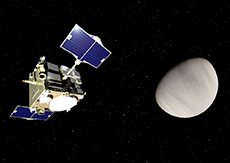 AKATSUKI
AKATSUKI
AKATSUKI is currently in an elliptical orbit around the equator of Venus, at an altitude of between 1,000 and 10,000 km at its nearest point, and about 360,000 km at its farthest, orbiting the planet in around 10 days. The initial plan was to have AKATSUKI complete one orbit in around 30 hours, so it is true that the orbit is much larger than originally planned. But we haven’t abandoned any of the original plans – we intend to accomplish them all. Luckily, the observation equipment is functioning properly, and as the cameras have some of the highest levels of resolution in the world, we believe that we will obtain satisfactory results from this orbit. I am sure you have also seen images from the meteorological satellite Himawari. Weather forecasts only show images of the skies above Japan, but in fact Himawari images the entire planet Earth. Orbiting the Earth from afar and getting a full view with one camera, it is possible to observe our planet’s climate as a whole. Similarly, AKATSUKI can study the Venusian climate from a position where it can observe the entire planet.
— Are you worried about AKATSUKI’s design lifespan?
We have already passed the original design lifespan of four and a half years, but AKATSUKI’s observation equipment is in very good condition. There has been no major deterioration, so, given the amount of fuel it has left, I feel we will be able to carry on for quite a long time. We will continue to operate with caution in order to keep the probe going as long as possible.
The long wait for AKATSUKI is over
— What has the international reaction been to the successful orbit insertion?
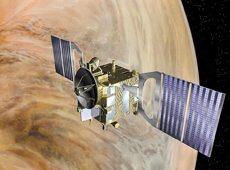 Venus Express (courtesy of ESA)
Venus Express (courtesy of ESA)
When the news broke that we had managed to put AKATSUKI into orbit, our mailboxes filled with congratulations from scientists all over the world. The Venus Express conference was held just after this, and I participated by videoconference. Everyone cheered and applauded for us. Venus Express is a European probe that observed Venus from 2006 to 2014. We have a great collaborative relationship with that team, to the point that we had a shared observation plan if AKATSUKI had arrived at Venus in 2010. In order to solve the puzzles discovered by Venus Express, we knew that we had to wait for AKATSUKI to arrive, so everyone was waiting eagerly for that day. Now there are a lot of expectations. More than anything we want to make sure that AKATSUKI’s observations are successful.
— What role will the Venus Express observations play in the AKATSUKI mission?
 Artist’s concept of lightning on Venus (courtesy of ESA/Christophe Carreau)
Artist’s concept of lightning on Venus (courtesy of ESA/Christophe Carreau)
The main goal of Venus Express was to study the chemical composition of the atmosphere and the surface, atmospheric motions to some extent, and electromagnetic environment around Venus. AKATSUKI is going to visualize the movements of the Venusian atmosphere in three dimensions. These are very different missions, but by combining the results of the two, we expect to be able to make a whole new set of discoveries.
Venus Express also observed the atmosphere using electromagnetic waves, and it did capture some waves that could feasibly have come from lightning. If there really is lightning on Venus, this will create another big puzzle for us. Lightning on Earth is caused by ice particles in clouds colliding and creating static electricity through friction. So if ice particles are required to create lightning, but there are no ice particles on Venus because of the scorching heat, how is that lightning created?
It may be that the mechanism that creates lightning on Venus defies conventional wisdom. On the other hand, there are scientists who don’t accept that there is lightning on Venus. They postulate that there is a high-altitude atmosphere around Venus that is charged with electricity, and that due to some kind of movement in this atmosphere, electromagnetic waves resembling lightning are created. AKATSUKI is equipped with a sensor that can capture the luminescence phenomenon of lightning, so we hope to settle this once and for all.
The mysteries of the wind
— What puzzle would you particularly like AKATSUKI to solve?
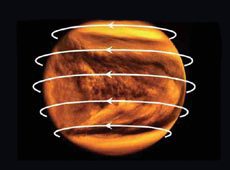 Super-rotation of Venus atmosphere
Super-rotation of Venus atmosphere
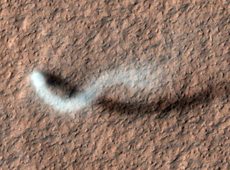 Sandstorm on Mars (courtesy of NASA/JPL/University of Arizona)
Sandstorm on Mars (courtesy of NASA/JPL/University of Arizona)
I would like to be able to solve the puzzle of the super-rotation of the Venusian atmosphere. There are a number of hypotheses about the cause of the super-rotation, but they are all theoretical, and we lack conclusive evidence. I think AKATSUKI will allow us to find a definitive answer, through observation of key phenomena and simulations using numerical models.
My own interest, though, is not just in Venus itself. My original interest was wind. When I was a student, I studied the Earth’s atmosphere, and I always had questions about why the wind blows the way it does. Around that time, I found out that the wind on the planet next door blew in a completely different, incomprehensible way. What are the differences between wind on Earth and wind on Venus? I thought that if we could understand these differences, we would finally be able to truly understand the wind on Earth. Once we understand the reasons wind behaves the way it does on Earth, we should be able to understand how our environment could change to become like Venus’s, and vice versa. I want to know about the boundaries of the differences between Earth and Venus.
Did you know that each celestial body has a different kind of wind blowing on it? Mars also has wind and storms and sometimes tornadoes. The planet next to Mars, Jupiter, also has many intriguing meteorological phenomena, including wind and lightning. Not to mention the fact that the Sun also has an atmosphere with blowing winds. Each of these celestial bodies has a different type of wind, but where do the differences come from? I really want to understand the fundamental reasons behind these differences. And furthermore, I would like to find out whether super-rotation exists on planets outside our solar system. We’ve discovered many planets outside our solar system that, like Venus, orbit a central star. Under the right conditions, I think we’ll be able to find similar phenomena outside the solar system.
— You really do like wind, don’t you?
I really do. I have always been very interested in the rotational mechanism of the flow of the atmosphere. In the end, we are all alive on Earth because the atmosphere flows. For example, Earth’s atmosphere distributes heat over the planet as a whole. If this stopped, heat would no longer be carried from south to north, the oceans in the equatorial zone would all evaporate, and the high latitude zones would freeze over. People would no longer be able to live in such a world of extremes. We are all able to breathe fresh air precisely because the atmosphere circulates. The circulation of the atmosphere creates a planet’s climate. In this sense, I think wind is very important.
Atmospheres are basically fluid, and fluids are connected. Therefore, wind is not a local thing but a continuum. For example, if a very strong wind blows in one location, it isn’t just blowing in that particular place. It’s only a small part of the wind that is blowing all over the world. And that wind is part of the jet stream that surrounds the entire planet. So when I feel the wind, what I’m feeling is the flow of the atmosphere that surrounds the whole Earth. That’s why I love being outside on really windy days!
The joy of turning conventional wisdom on its head
— What are your current goals?

First of all, there are the original goals of AKATSUKI: obtaining a proper explanation for the phenomenon of super-rotation and the sulfuric acid clouds. After that, I want to see how far I can get with solving the new puzzles that will come up in the future. Before we started getting the initial observation images, we scientists had long been imagining what kinds of pictures of Venus these cameras would give us. But our imagination was completely turned on its head. Thee images are different from what was accepted knowledge until now, and they’ve have created another new puzzle. But the more conventional wisdom is overturned, the happier we are. This is because each time that happens, it’s a starting point for new research. AKATSUKI will show us new images of Venus that are beyond our imagination. I think the challenge for researchers when they see these is to let go of preconceived notions and make as many new discoveries as possible. I want to broaden the results we get from AKATSUKI – not just discovering new puzzles, but creating new science.
Something else that requires consideration is future development. How are planets formed? What is the secret behind the creation of an environment like Earth’s? When we think about questions like this, there is no way that everything will end with AKATSUKI. The next mission might be to Mars, to Venus, or another planet. My biggest goal is to launch the next probe as soon as possible, in order to explain the structure of another planet’s environment.
— Do you have a final message for the readers?
Please continue to pay attentions to AKATSUKI. Once full-scale observation begins this spring, we will be able to see video of the Venusian atmosphere. If we achieve this, we would very much like to make this video public. Following this, we plan to announce results from AKATSUKI. We would be very happy if you were able to join us in experiencing the fun of finding out that what you imagined is completely wrong. We would like you to look at a new world in a new way along with us. And I would also be very happy if some of the readers developed an interest in the science of planetary atmospheres. I hope you will join us in following AKATSUKI’s scientific journey on Venus.
Takeshi Imamura, Ph.D.

Associate Professor, Department of Solar System Sciences, Institute of Space and Astronautical Science, JAXA
Dr. Imamura received his Ph.D. in 1998 from the Department of Earth and Planetary Physics at the University of Tokyo.
He has been involved in radio science observations of the Mars explorer NOZOMI, the SELenological and Engineering Explorer KAGUYA (SELENE), and AKATSUKI. He specializes in planetary atmospheric science.
[ April. 14, 2016 ]
Comments are closed.